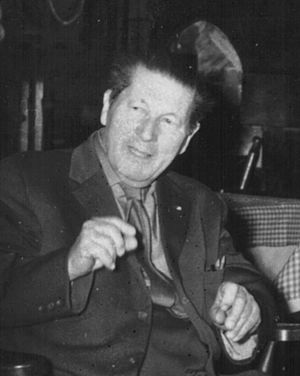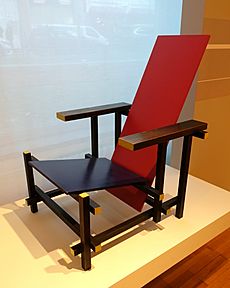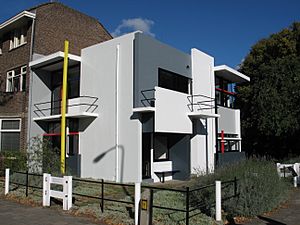Gerrit Rietveld facts for kids
Quick facts for kids
Gerrit Rietveld
|
|
|---|---|

Rietveld in 1962
|
|
| Born |
Gerrit Thomas Rietveld
24 June 1888 Utrecht, Netherlands
|
| Died | 25 June 1964 (aged 76) Utrecht, Netherlands
|
| Occupation | Furniture designer and architect |
Gerrit Rietveld (born June 24, 1888 – died June 25, 1964) was a famous Dutch furniture designer and architect. He is known for his unique designs, especially his colorful furniture and modern buildings. His work helped shape the De Stijl art movement.
Contents
Early Life and Learning
Gerrit Rietveld was born in Utrecht, a city in the Netherlands, on June 24, 1888. His father was a joiner, someone who builds things with wood. Gerrit left school when he was only 11 years old to work as an apprentice for his father. This means he learned the trade by helping his dad.
He also went to night school to study more. Later, from 1906 to 1911, he worked as a draughtsman for a jewelry company. A draughtsman draws detailed plans for designs.
The De Stijl Movement
In 1917, Rietveld opened his own workshop where he made furniture. He had taught himself how to draw, paint, and make models.
One of his most famous designs is the Red and Blue Chair, which he created in 1917. This chair became a very important piece of modern furniture. Rietveld hoped that his furniture could be made in factories, not just by hand. This is why he focused on simple designs that were easy to build.
In 1918, he started his own furniture factory. Around this time, he joined a group of artists and designers called De Stijl. This Dutch word means "The Style." The De Stijl movement used simple shapes, straight lines, and primary colors like red, blue, and yellow. After joining, Rietveld changed the colors of his famous chair to red, blue, and yellow to match the movement's ideas. He also became an architect in 1919.
Being part of De Stijl helped Rietveld show his work in other countries. In 1923, a famous architect named Walter Gropius invited Rietveld to show his designs at the Bauhaus, a very important art school in Germany.
One of Rietveld's most famous buildings is the Rietveld Schröder House. He built it in 1924 with the help of the owner, Truus Schröder-Schräder. The house is in Utrecht. The ground floor looks quite normal, but the top floor is very special. It doesn't have fixed walls. Instead, it uses sliding walls that can be moved to change the size and shape of the rooms. This house has been a UNESCO World Heritage Site since 2000. This means it's a very important place recognized globally.
New Ideas in Architecture
In 1928, Rietveld left the De Stijl group. He started to focus on a more practical and useful style of architecture. This style was known as Nieuwe Zakelijkheid or Nieuwe Bouwen, which means "New Objectivity" or "New Building." In the same year, he joined a group called the Congrès Internationaux d'Architecture Moderne, which discussed modern architecture.
From the late 1920s, Rietveld became very interested in designing social housing. This meant creating affordable homes for many people. He also explored new ways to build, using new materials and methods like prefabrication (making parts of a building in a factory) and standardization (using standard sizes and parts). For example, in 1927, he experimented with prefabricated concrete slabs, which was very new at the time.
Even though he had these modern ideas, most of his early projects were for private clients. It wasn't until the 1950s that he could build his ideas for social housing in cities like Utrecht.
Rietveld designed the Zig-Zag Chair in 1934. He also started designing the Van Gogh Museum in Amsterdam. This museum was finished after he passed away.
De Stijl Becomes Popular Again
In 1951, Rietveld designed an exhibition about De Stijl. This show traveled to Amsterdam, Venice, and New York. Because of this, people became interested in his work again.
In the years that followed, he received many new projects. These included designing the Dutch pavilion for the Venice Biennale (a big art exhibition) in 1953. He also designed art academies in Amsterdam and Arnhem, and a press room for the UNESCO building in Paris.
In 1955, Rietveld designed the ‘Sonsbeek Pavilion’ to display small sculptures. This pavilion was rebuilt at the Kröller-Müller Museum in 1965. It was rebuilt again in 2010 because of damage over time. To handle all these projects, Rietveld started a partnership with other architects in 1961. Together, they built many homes, especially in Utrecht.
Death and Legacy
Gerrit Rietveld died on June 25, 1964, in Utrecht. His son, Wim Rietveld, also became a well-known industrial designer.
Recognition and Influence
Rietveld's first exhibition focused on his architecture was held in Utrecht in 1958. In 1968, an art academy in Amsterdam was renamed the Gerrit Rietveld Academy in his honor. This shows how important his work was.
In 1988, an exhibition in New York called "Gerrit Rietveld: A Centenary Exhibition" showed many of his original works. Another exhibition in Utrecht, "Rietveld’s Universe," compared his work to other famous architects like Wright and Le Corbusier.
Two computer programs used for checking computer code are named after Gerrit Rietveld: Gerrit and Rietveld.
See also
 In Spanish: Gerrit Rietveld para niños
In Spanish: Gerrit Rietveld para niños





